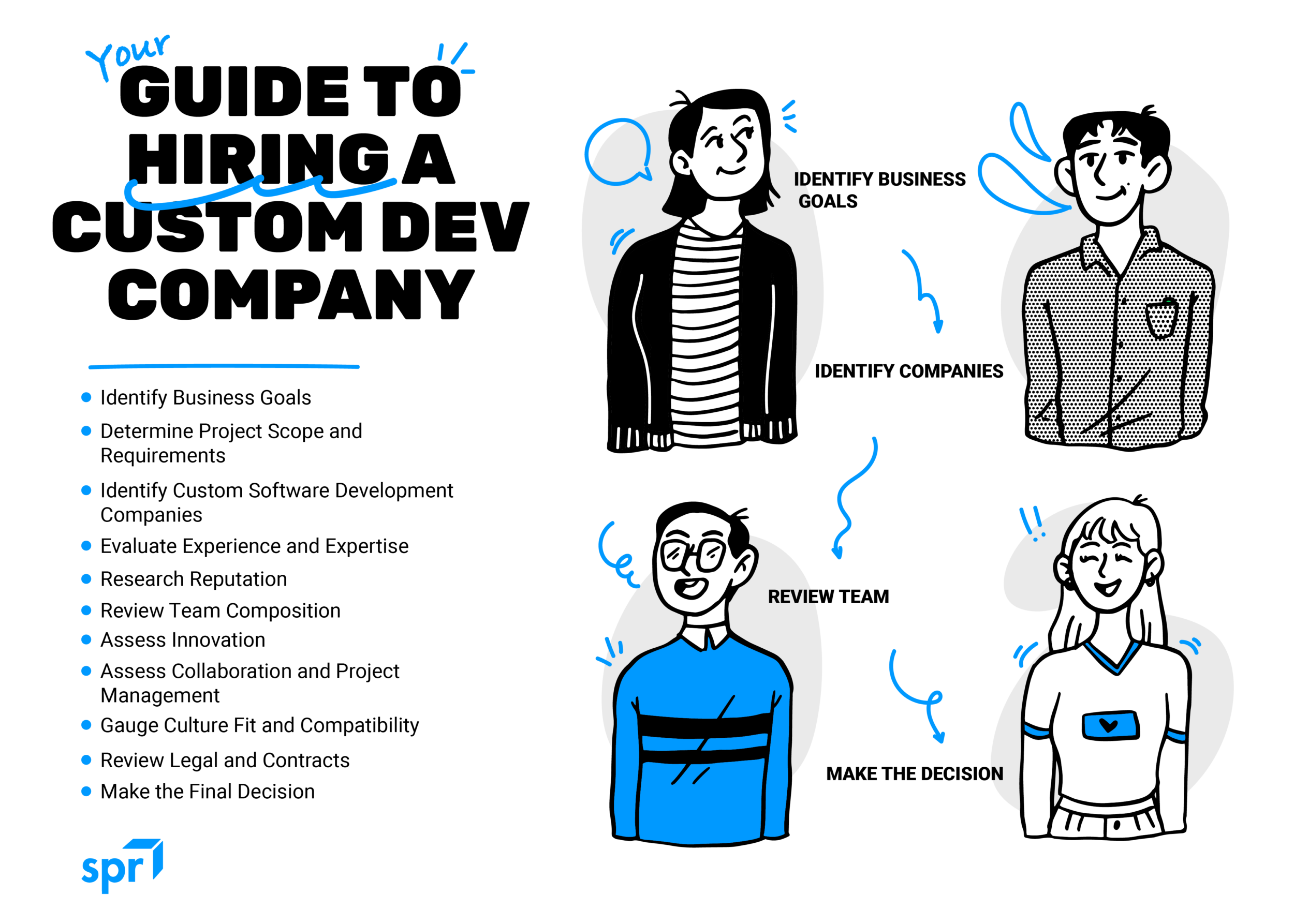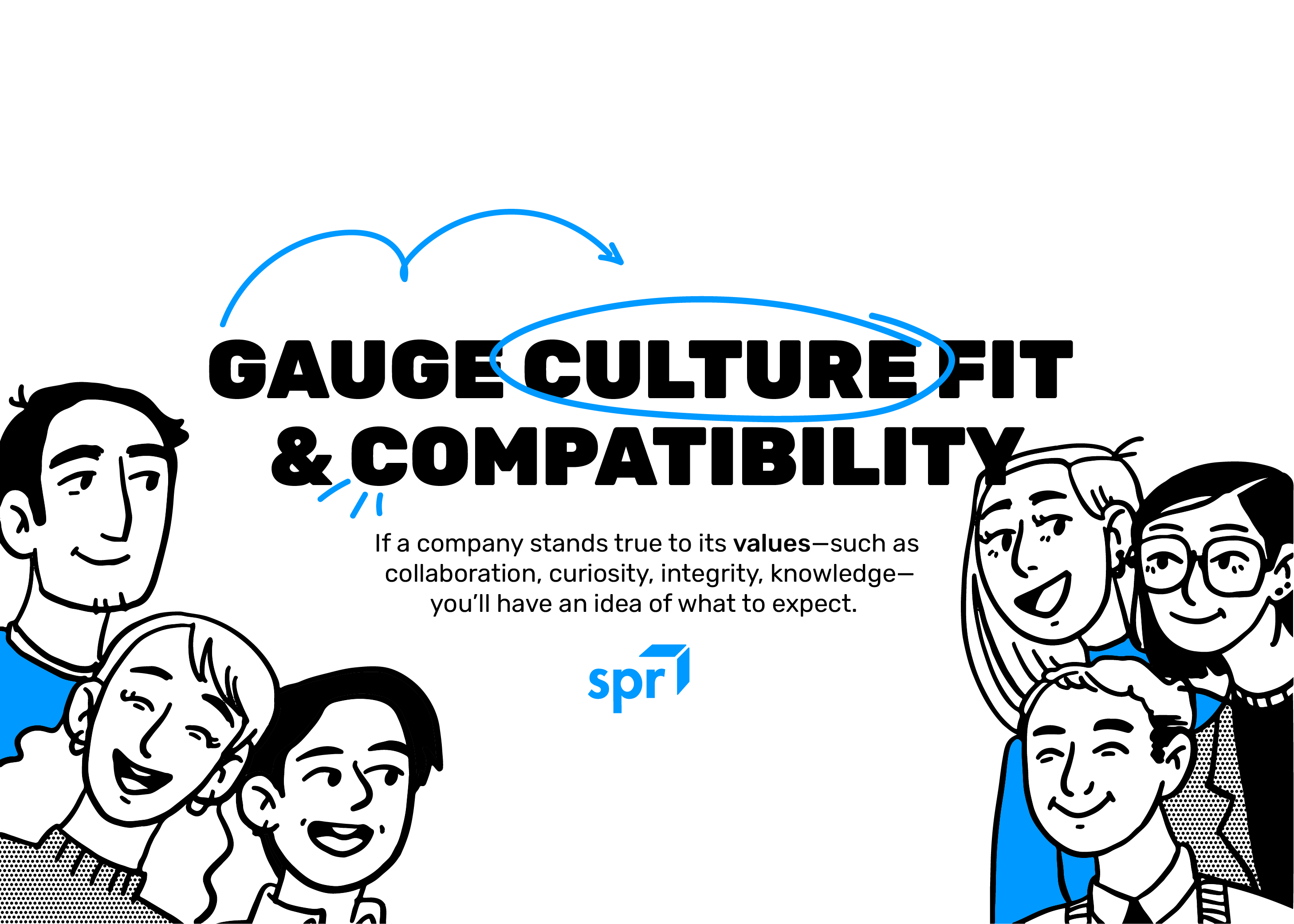Your Guide to Hiring a Custom Software Development Company
You’ve got a great idea for custom software, now you just need the right partner to bring it to life. The problem is…you have no idea where to start! Depending on the scope of your project, partnering with a custom development company could prove especially beneficial. Hiring a team offers significant benefits including access to specialized expertise, scalable solutions designed to meet your goals, and a sharp focus on quality and innovation. Most companies are adept at streamlining the development process, adapt quickly to changes, and ensure robust, long-term support. The result is a solution that offers greater flexibility and a competitive edge—and who doesn’t want that?
Here, we’ve provided a step-by-step guide to navigating the hiring process so you’ll know exactly how to hire a software development company.

Step 1: Identify Business Goals
Before you begin to look for a partner, take time to carefully consider what you hope to achieve. When it comes to identifying your business goals, a few key questions include:
- What specific problems will this software solve for our business (or users)?
- How does it align with our overall business goals or strategy?
- What outcomes do we expect from this project?
- How will we measure success?
- What does successful collaboration look like?
Having clear answers to these questions will make it much easier to communicate your vision to potential software development partners. Plus, not only will the clarity save time, it will also reduce the risk of misunderstandings down the line.
Step 2: Determine Project Scope and Requirements
Next, you’ll want to consider the important details of your project. For instance:
- What key features and functionalities must the software have?
- Who will use the software?
- Will the software run on the web, mobile, or both platforms?
- What is your overall budget and timeline for project completion?
Understanding the full gamut of functional and non-functional requirements, budget, and timeline is key to level-setting expectations with a potential partner. For example, functional requirements could include features like user authentication, data input and retrieval, or integration with third-party services such as email platforms or CRMs. Non-functional requirements, on the other hand, address how the software performs and may specify that the system must support 1,000 concurrent users without lagging, ensure 99.9% uptime, or maintain compliance with industry standards such as GDPR. Providing this level of detail makes it easier for your development partner to provide an accurate proposal and cost estimate. You may even consider creating a basic project roadmap or wireframes to illustrate your vision and highlight any important user flows or key interfaces.
Step 3: Identify Custom Software Development Companies
When it comes time to begin the search, there are a few methods you can count on to find reliable software development companies. The obvious place to start is with an online search. Beyond looking at the top-ranked Google results and reviews, visit directories like Clutch and GoodFirms to find highly-rated companies within a specific niche.
Word of mouth is also a great way to get recommendations—ask colleagues, friends, or industry contacts for referrals to companies they’ve worked with successfully. For example, 87% of SPR’s work is from repeat customers or referrals.
If you have the time, search for networking events in your area, and attend tech meetups, conferences, or industry events to meet developers and learn firsthand about what they have to offer. At SPR, for instance, we host a Tech Leadership Exchange a couple of times a year to bring together industry experts in the Greater Chicago area.
Once you have a list of potential candidates, dig deeper to understand each company’s background and specialization to see if they’re a good fit for your project. Reviewing case studies is a great way to uncover the type of clients they take on and what work they’ve done in the past—which brings us to the next step.
Step 4: Evaluate Experience and Expertise
Case studies say a lot about a company’s breadth of experience and expertise. Does their website feature one or two case studies, or do they have more than you can count? Do any of the case studies match your industry or speak to a similar problem that your business is trying to solve? As you review case studies, focus on the following:
- Projects like yours in size and complexity
- Industries they’ve worked in, especially as it relates to your own, e.g. private equity, logistics, or healthcare
- Tools, frameworks, and technologies they specialize in
- The results that they have achieved
Completing this step helps to ensure that the company has the skills and expertise required to handle your specific project. We are proud of the breadth of our work at SPR, and love when potential partners share a case study that motivated them to engage with us.
Step 5: Research Reputation
From Google and other third-party reviews to industry ratings, client testimonials, references, and past client feedback, each of these can help to inform your decision-making process.
At SPR, we have a strong reputation for delivering “beyond the build,” which essentially means that we go above and beyond for our clients, even after the work is considered done. We’re undeniably reliable, excellent communicators, and we deliver high-quality work, time and time again. And we’re proud to see this reputation reflected in various client testimonials across our website.

Step 6: Review Team Composition
As you home in on the best partner for your project, you’ll want to consider the people who make up the project team. First and foremost, you’ll want to understand who is involved; typically, the team will consist of developers, designers, and project managers, plus testing and QA (quality assurance). Consider their technical certifications and level of expertise, plus any specialized training they’ve received, and whether the team size matches the demands of your project. At SPR, we make a point to build a team of various skillsets and levels of expertise, always led by a senior subject matter expert.
Finally, if possible, take some time to connect with team members to gauge whether it’s a culture and personality fit. Are these people you can see yourself collaborating with daily? A well-rounded team that is as personable as it is skilled will make all the difference.
Step 7: Assess Innovation
If you want to set your project apart and ensure it stands the test of time, consider the company’s level of innovation. To assess this, ask:
- What creative and/or custom solutions have they provided for other clients?
- Do they stay up to date on new technologies and industry trends? If so, how?
- Are they willing to think outside the box to enhance your specific project?
- What’s their take on innovation and modernization, in general?
company that values innovation will help to set your software apart from the competition and bring success for years to come.
Step 8: Assess Collaboration and Project Management
At this point in the process, you most definitely should be having a face-to-face conversation with someone from the team, as you may not uncover details about collaboration and project management by surfing a website alone. Sound project management is crucial for keeping a project on track. Key questions that you can ask include:
- Will you have a dedicated project manager to oversee communication, goals, and milestones?
- How often will you meet with the PM and/or receive progress updates?
- What tools and methods do they use to manage projects? (e.g. Agile, or as we like to say ‘DevTestOps’)
At SPR, our project management team is dedicated to collaborating with you to understand your goals, manage strategic initiatives, and accelerate the delivery of important projects. Our expert consultants embed seamlessly into your team to lead a software development project from start to finish using agile methods. We take an iterative approach that improves team efficiency, product quality, and project predictability.
Step 9: Gauge Culture Fit and Compatibility
As hinted at above, a good working relationship depends on more than just skills. You’ll want to make sure the company’s culture and values align with yours. How do you know if you’re aligned? Consider their core values—often these are posted on a website, and if not, just ask! If a company stands true to its values—say for instance, collaboration, curiosity, integrity, knowledge, and so on—you’ll have an idea of what to expect. You can also ask about their approach to collaboration and communication, and their ability to be flexible and adaptable to your needs.
At SPR, we like to say that what differentiates us isn't what we do, but how we do it. From proactive advice and knowledge sharing to agile response and deep discovery, we deeply value our client relationships and always go the extra mile to achieve the best outcomes.

Step 10: Review Legal and Contracts
Reviewing a contract thoroughly before signing is essential to ensure you understand the agreement's details, terms, and potential implications. Include a non-disclosure agreement (NDA) before moving too far into conversations with a new-to-you firm. Make sure to verify key aspects like payment terms and schedules, deliverables, timelines, confidentiality clauses, and intellectual property (IP) rights—in most cases with custom software, you’ll want to retain ownership and/or clearly define usage rights.
You’ll also want to review dispute resolution clauses so that you know how issues will be handled from a legal perspective. By scrutinizing the terms, you can address ambiguities, identify unfavorable terms, and negotiate adjustments before committing. And if you’re unsure about any part of the contract, consider consulting a legal expert.
Step 11: Make the Final Decision
As you move toward making a final decision, chances are you’ll have a couple of strong proposals from different software development partners. To narrow it down, weigh the cost against the value each partner brings to your project. While you will want to stick reasonably close to budget, it’s also important to look beyond the cost and assess factors like expertise, proven track record, alignment with your goals, and the quality of their proposed solutions. A partner with the right expertise and experience may cost a little more up front but could end up leading to cost savings (or fewer headaches) down the road simply because they know what they’re doing, i.e. you can expect better results, fewer delays, and long-term scalability.
Once you’ve made your final selection, you’ll want to have a clear plan for project kickoff, including timelines, deliverables, and communication protocols, ensuring everyone is on the same page.
Hiring Your Custom Development Partner
Hiring a software development company can feel overwhelming, but following these steps can simplify the process. By taking the time to define your goals, research your options, and assess potential partners thoroughly, you can—and will—find a reliable team to bring your project to life.
Ready to take the next step in your search? Get in touch with one of our team members to get the conversation started.


